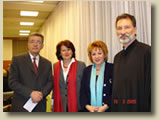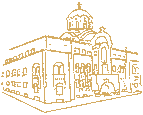| Information
Service of
the Serbian Orthodox Church
March 17,
2005

ONE YEAR AFTER MARCH POGROM, A DARK SHADOW
STILL
HOVERS OVER KOSOVO
 A
year after the tragic events of March 2004 in which Kosovo
Serbs and Roma
experienced their "Kristallnacht" despite
the presence of thousands of NATO-led peacekeepers and the UN
Mission hardly anything seems to have changed for the better
in Kosovo. Although the international community has strongly
condemned the ethnic Albanian riots and the Kosovo Government
has reconstructed part of the destroyed homes under international
pressure, only a handful of the 4,000 Serbs and Roma expelled
at that time have returned to their homes. They do not feel safe
in a society where ethnic discrimination has become a regular
pattern of life and where no one can grant them security and
freedom. Medieval Serbian churches still lie in ruins, desecrated
Christian cemeteries are still covered by garbage, there is no
freedom of movement and no normal life. The remaining Serbs in
Kosovo and Metohija remember the tragic anniversary with constant
fear of renewed Albanian violence as recent explosions in Kosovo
cities warn that the restive province remains a powder keg. A
year after the tragic events of March 2004 in which Kosovo
Serbs and Roma
experienced their "Kristallnacht" despite
the presence of thousands of NATO-led peacekeepers and the UN
Mission hardly anything seems to have changed for the better
in Kosovo. Although the international community has strongly
condemned the ethnic Albanian riots and the Kosovo Government
has reconstructed part of the destroyed homes under international
pressure, only a handful of the 4,000 Serbs and Roma expelled
at that time have returned to their homes. They do not feel safe
in a society where ethnic discrimination has become a regular
pattern of life and where no one can grant them security and
freedom. Medieval Serbian churches still lie in ruins, desecrated
Christian cemeteries are still covered by garbage, there is no
freedom of movement and no normal life. The remaining Serbs in
Kosovo and Metohija remember the tragic anniversary with constant
fear of renewed Albanian violence as recent explosions in Kosovo
cities warn that the restive province remains a powder keg.
 Today Kosovo is far from resembling a multiethnic society where
all citizens would be able to find their home and build their
future normally. It looks more and more like the black hole of
the European continent, and everyone seems to be at a loss what
to do with it. The most tragic thing is that the international
community has not found the strength nor moderate Albanians the
decency to identify and name the main organizers of last year's
pogrom. One hears only abstract condemnations and attempts to
rationalize the violence; some even dared call it heroism. The
main organizers who orchestrated a crowd of 60,000 people, provided
bus transport from the remotest parts of the Province and arranged
a blockade of KFOR in their bases still enjoy tacit immunity. Today Kosovo is far from resembling a multiethnic society where
all citizens would be able to find their home and build their
future normally. It looks more and more like the black hole of
the European continent, and everyone seems to be at a loss what
to do with it. The most tragic thing is that the international
community has not found the strength nor moderate Albanians the
decency to identify and name the main organizers of last year's
pogrom. One hears only abstract condemnations and attempts to
rationalize the violence; some even dared call it heroism. The
main organizers who orchestrated a crowd of 60,000 people, provided
bus transport from the remotest parts of the Province and arranged
a blockade of KFOR in their bases still enjoy tacit immunity.
 While some Kosovo Albanian extremist organizations today will
be honoring the rioters killed by international police and KFOR
while they were burning down Serb homes and churches, the Serbian
people will gather in their churches to mark this tragic anniversary,
remembering the innocent victims who lost their lives only because
they wished to remain in their homes and peacefully live their
lives. With their silent prayer, the remaining Serbs will once
again raise their voice against injustice and violence, lies
and hypocrisy in the hope that the March pogrom will never happen
again. While some Kosovo Albanian extremist organizations today will
be honoring the rioters killed by international police and KFOR
while they were burning down Serb homes and churches, the Serbian
people will gather in their churches to mark this tragic anniversary,
remembering the innocent victims who lost their lives only because
they wished to remain in their homes and peacefully live their
lives. With their silent prayer, the remaining Serbs will once
again raise their voice against injustice and violence, lies
and hypocrisy in the hope that the March pogrom will never happen
again.
On the first anniversary of the meticulously planned and ethnically
motivated campaign of terror, we are left once again to recap
the dark toll. A total of 19 people were killed, some 800 Serbian
houses were torched and destroyed, 34 Serbian Orthodox holy shrines
were demolished and devastated (increasing the total of monasteries
and churches destroyed since June 1999 to about 150), 4,000 Serbs
were expelled, and some 900 people were beaten up and seriously
injured.
Source: ERP KIM Info Service

SALES EXHIBITION OF ICONS AND FRESCOES
TO BENEFIT FUND FOR KOSOVO
On the anniversary of the March 2004 pogrom against the Serbs
of Kosovo and Metohija and the torching and destruction of Orthodox
Christian holy shrines, on March 17, 2005 at 6:00 p.m., a sales
exhibition of icons and copies of frescoes from the churches
and monasteries of Kosovo and Metohija will be opened in the
Gallery of Frescoes in Belgrade, Cara Urosa Street number 20.
The icons and frescoes, works by the students of the Serbian
Orthodox Church Academy of Arts and Conservation from the class
of Professor Goran Janicijevic, will be exhibited in the Gallery
of Frescoes until March 24, 2005.
Also in the Gallery of Frescoes, Dr. Predrag Ristic, professor
at the Serbian Orthodox Church Academy of Arts, will be lecturing
on March 21 at 6:00 p.m. on the topic “Traces of Logos in the
foundations of Holy Archangels”, and on March 24 at 6:00 p.m.
Miroslav Stanojlovic, also a professor at the Academy, will speak
on “Painting conservation work on the frescoes of the Church
of the Ascension at the monastery of Milesevo (The Last Supper
and St. Sava)”. While the exhibition is open short concerts will
also be held by the choir of the Theological Faculty of the Serbian
Orthodox Church (March 17), the choir of the churches of the
Most Holy Theotokos - Ruzica and St. Paraskeva in Kalemegdan
Park (March 21) and the Unity Choir of the church of St. George
in Smederevo (March 24), which on that occasion will be joining
the Association of Serbian Choirs.
All proceeds from icons and frescoes that are sold will be donated
to the Fund for Kosovo and Metohija.

PUBLIC FORUM ON SUNDAY OF ORTHODOXY AT THE ORTHODOX THEOLOGICAL
FACULTY IN BELGRADE On the occasion of the Sunday of Orthodoxy the Orthodox Theological
Faculty of the University of Belgrade is organizing a public
forum on the theme “The icon – past and present” to be held on
Monday, March 21, 2005 at 7:00 p.m. Speakers will include Oliver
Tomic on “The icon throughout the history of the Church” (including
visual presentation) and Protopresbyter Stamatis Skliris on the
theme “A post-modern re-examination of Byzantine painting”. The
moderator will be His Grace Bishop Maksim of Hum, a professor
at the Theological Faculty.

HIEROMONK IRINEJ DOBRIJEVIC LECTURES
AT BOSTON UNIVERSITY SYMPOSIUM
IN VIENNA
 Hieromonk Irinej (Dobrijevic), consultant to the Holy Synod
of Bishops of the Serbian Orthodox Church, was an active participant
in an international symposium under the joint auspices of Boston
University and the J.M. Dawson Institute of Church-State Studies
at Baylor University on “The Orthodox spirit and capitalist ethics”
held at the Institute for Social Studies in Vienna from March
7-9, 2005. Hieromonk Irinej (Dobrijevic), consultant to the Holy Synod
of Bishops of the Serbian Orthodox Church, was an active participant
in an international symposium under the joint auspices of Boston
University and the J.M. Dawson Institute of Church-State Studies
at Baylor University on “The Orthodox spirit and capitalist ethics”
held at the Institute for Social Studies in Vienna from March
7-9, 2005.
Participants in the symposium included Dr. Peter Berger, the
eminent sociologist of Boston University; Mr. Christof Mihalski
of the Institute for Social Studies; Dr. Vladimir Mau of the
Moscow Academy for National Economy; Protopresbyter Leonid Kishkovsky
of the Orthodox Church in America; Dr. Janos Kovacs of the Institute
for Social Studies; Dr Christopher Marsh of the J.M. Dawson Institute
of Church-State Studies at Baylor University; Dr. Charles Cross
of the Military Air Force Academy of the United States of America;
Mrs. Valentina Fedeterova of the Russian Academy of Sciences;
Protopresybter Dr. Michael Plekon of New York’s City University;
Miss Irina Papkova of Georgetown University; Dr. Elizabeth Prodromou
of Boston University; Dr. Daniela Kalkandjieva of the University
of Sophia; and Hieromonk Irinej (Dobrijevic), consultant for
international and inter-church relations to the Holy Synod of
Bishops of the Serbian Orthodox Church. Participants in the discussion
included His Grace Bishop of Vienna, Dr. Ilarion (Alfeev) of
the Russian Orthodox Church, the representative of the ROC to
the European Union; and Dr. Ingeborg Gabriel of the University
of Vienna.
The main theme of this conference was the Orthodox perspective
of the major work of Max Weber, Protestant ethnics and the spirit
of capitalism, with comparative presentations on the development
of open economies in modern countries where Orthodox Churches
are in the majority; as well as the relevancy of all local Orthodox
Church in the creation of consciousness according to the principles
of social rights and correlation of faith and acts. According
to the research of Max Weber, and the teaching of Calvinist Protestantism,
wealth is a direct indicator of God’s favor and membership of
the chosen people of God. In his presentation, “The Orthodox
spirit and capitalist ethics: The case of Serbia and Montenegro”,
Hieromonk Irinej emphasized arguments against Weber’s thesis,
because the Orthodox ideal in economic matters means the achievement
of a balance between wealth and poverty, between the concrete
needs of the individual and the prosperity of society as a whole.
Fr. Irinej stressed that fruitful work is an important element
of the human experience of every individual. That is the reason
why the emphasis in Orthodoxy is placed on economic independence
where a solid “middle class” predominates that neither subsists
at the minimal level of existence nor wallows in luxury.

TURKISH MAYOR REMOVES STATUE OF ST NICHOLAS OF MYRRA The Turkish mayor has decided to remove a bronze statue of St.
Nicholas of Myrra and replace it with a brightly colored model
of his modern incarnation, Santa Claus.
St. Nicholas, a fourth century Christian bishop who lived and
worked in what is now the southern Turkish town of Demre, is
revered throughout the Christian world. For that very reason,
a Russian artist donated the bronze statue of the saint five
years ago.
The old statue of Saint Nicholas, with arms outstretched and
one hand holding the Bible, has been re-housed in a local museum
from its previous vantage point towering over a town square.
Source: ASSYRIAN INTERNATIONAL NEWS AGENCY

[Serbian
Translation Services]

Copyright © 1999-2004 by
The Information Service of the Serbian Orthodox Church
11000 Belgrade
Kralja Petra I no.5
+381 11 3282 596
e-mail
|

